The pharmaceutical shills at Healthline are at it again, publishing their usual nonsensical backwards-thinking rubbish. This time they praise the importance of vitamin K and recommend extremely toxic food sources without mentioning anything about bioavailability and the different chemical forms, as in non-active inorganic (plants) and the active organic forms (animals,) nor how these forms present themselves within the body, and how our body handles them.
They are either outright lying to their audience, or they are completely ignorant of human biology and biochemistry. Either Way, it’s pathetic and vile. So, let’s get it on.
“You can get dietary vitamin K from vegetables, including leafy greens, and from animal sources, including some dairy products and types of meat.”
Yes, but they’re completely different. Plants only contain phylloquinone (vitamin K1) which is an inorganic source that is chemically different to how we as mammals store and use vitamin K1.


Animal foods contain small amounts of the pretty useless vitamin K1, but it is in its correct active organic and bioavailable form, and thus fully usable from the get go. Animal-based foods also contain the much more important vitamin K2, which is not even present in plants.


It should also be noted that since vitamin K1 is rarely needed by our bodies, it only has a half-life of 1-2 hours, while the important vitamin K2, which also can substitute for K1, has a half-life of 3-7 days.

And with that, we could actually conclude the article. But let’s see where these shills are going.
“Vitamin K is an important nutrient that plays a vital role in blood clotting and bone and heart health.
While vitamin K deficiency is rare, suboptimal intake may impair your health over time. Inadequate intake may impair blood clotting, weaken your bones, and increase your risk of heart disease.”
Yes, that is the current understanding. And yes, in that case, a deficiency would impact these roles of vitamin K within the human body.
“For this reason, you should make sure to obtain plenty of this vitamin from your diet. Getting the Daily Value (DV) of 120 mcg should prevent insufficiency in most people.”
Well, for males it’s 120 mcg, and for females it’s 90 mcg. However, these numbers are theoretical and derived from the average population — a population that consumes mostly plant-based garbage and processed foods. These foods contain the wrong inorganic form of vitamin K, which means that only a small fraction of these 120 mcg or 90 mcg will actually be absorbed and converted into its active form and used by tissues. And since the DV recommendations are based on blood tests and theoretical conclusions by alleged “experts,” the vitamin K measured in the blood does not differentiate between inorganic and organic forms, it only measures the total concentration. And thus, it only shows the average intake of vitamin K from food in what is believed to be “healthy people” used as a reference for their recommendations. This means that the actual DV is likely lower, as most of what was measured will never be used by the body.

And this also means that if you are intelligent and mostly consume animal-based foods, which have the correct bioavailable and active form, the recommended DV will even lower, as more than 90% is absorbed.
This explains why vitamin K and other vitamins as well, are found in lower concentrations in animal foods than in plant foods. Because we do not need more than what is present in the animal foods, as that is what the animal stores and uses to maintain perfect health. And again, all vitamins and other nutrients found in animal foods are already fully bioavailable and in its active form, and thus easily digested and used by our bodies.


And as I’ve mentioned many times, you can never eat to much of a single nutrient or vitamin if it’s in it’s active organic form, as the body actually can recognize it and will only use and store what it can and need, the rest will be expelled from the body (which is not the case with inorganic compounds from plants that will bind to tissues and cause damage.)

All this is simple logic, especially if you understand a little about biology and biochemistry. Alas, none within the backwards-thinking and corrupted medical field do. They’re all brainwashed low-IQ puppets.
Which foods contain vitamin K?
“Vitamin K is a group of compounds divided into two groups — K1 (phylloquinone) and K2 (menaquinone).”
Yes, I already mentioned this.
“Vitamin K1, the most common form, is mainly found in plant foods. The best sources of vitamin K1 (phylloquinone) are dark, leafy green vegetables. In fact, the prefix “phyllo” in this vitamin’s name refers to leaves.”
While it might be the most common due to all the variations of toxic plant foods, you forgot to mention that it’s also the most useless form, as it’s inorganic and also sparingly used by the body in its active form. Vitamin K1 is almost useless, and that is why animal-based foods contain so little of it, because it’s not needed. If it was important, more of it would be present in tissues and organs, but it’s not. Again, simple logic. And you failed.

“K2, on the other hand, is only found in animal foods and fermented plant foods, such as natto. However, exact data about the exact amounts of K2 in foods is currently limited.”
Yes, in animal-based foods. As for fermented plants, it’s still the wrong inorganic chemical form, and it has to be converted within the body, a process that yields very low results and leaves a lot of toxic residues. I’ve covered this in many articles.
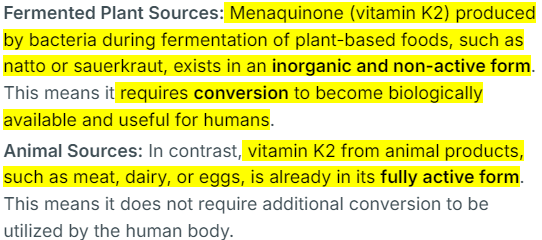
With that said, it is true that the data on K2 content in animal foods is limited, as they know it’s the important vitamin K, and they want to keep you weak and reduce your lifespan, so they push for the plant-based agenda and for vitamin K1, the useless vitamin.
And after this, Healthline lists 20 foods that are supposedly high in vitamin K, of which 18 were plants, as in the mostly useless and non-bioavailable vitamin K1. The only two animal foods they included were chicken thigh and chicken breast, which are not that high in vitamin K1, not compared to fatty red meat or especially organ meats such as liver, or even dairy, which has a lot of vitamin K (especially cottage cheese and full fat fermented cheeses and yogurt.)
If people go by Healthline’s retarded list, they will severely poison themselves from all the plant toxins. Such a bunch of pathetic low-lives.
Then they made a list of 5 foods with vitamin K2, where they put pepperoni sausage at the top, a processed food that does not even count as an animal-based food, as the processing makes it toxic from added sugar, food starch, onion powder, nutmeg, ginger, sodium tripolyphosphate, sodium erythorbate and other extremely toxic food additives. Frickin’ morons!
They did however mention ground beef and chicken liver. I would say any fatty red meat, liver, and any dairy products that are as unprocessed as possible.
After that they covered 5 toxic berries and 5 extremely toxic legumes. There’s simply no stop to their insanity. It almost made my eyes bleed. And with that said, their next statement literally made my eyes bleed.
“The richest sources of vitamin K1 are dark, leafy green vegetables. For example, just 1/2 cup (59 grams) of cooked kale provides 205% of the DV.”
Are you truly that retarded? Kale is the most toxic and damaging plant of all leafy greens. It has frikkin’ killed sheep who were fed that deadly crap! And any “nutrients” in leafy greens are extremely poorly absorbed in the small intestine of humans!

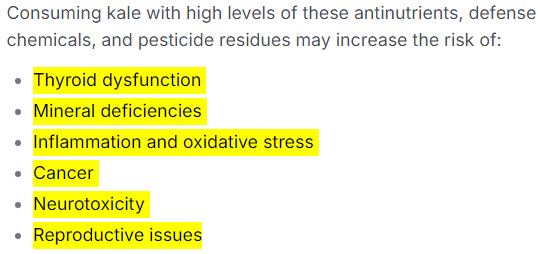
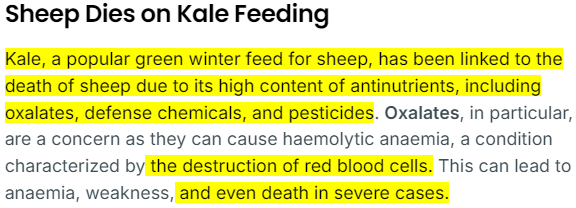

So again, it will not provide any fantasy figures of 205% of the DV you frikkin retards. How can you be so ignorant of simple biology and biochemistry?
First, most “nutrients” in plants are bound to antinutrients, cellulose and fiber, so what’s on the label (found in a test tube) will not be what your body may be able to absorb. At best, 10 to 15% of vitamin K1 can be extracted from a leafy green in the small intestine. That’s abysmal!

Also, as the nutrient, in this case vitamin K1, is inorganic, as in the wrong chemical form, it has to be broken down and converted, if possible, into something the body can actually use. And while your body may be able to convert anywhere from 10 to 40% or thereabouts of a vitamin to something bioavailable, the remaining inorganic nutrients has to be discarded through detoxification processes and a lot of it will actually attach to tissues, and being a foreign inorganic compound, it will be very toxic causing tissue damage. I’ve explained this in many other articles.


So, let’s say that a toxic serving of useless kale provides 246 mcg of inorganic vitamin K1, then 15%, which is about 37 mcg can make its way to the liver to be reduced and then it will bind with proteins and be activated by specific enzymes. Once it goes through the several steps of conversion, at best, 20% or so of these 37 mcg might be activated. So, of the 246 mcg vitamin K in toxic kale we get about 7.5 mcg of active vitamin K (but probably less.) And guess what, 7.5 mcg is 6.25% of the DV. That’s quite a cry from the fantasy numbers of 205% dreamed up by the shills at Healthline. And also, it’s vitamin K1 and no K2 at all. Again, learn some basic biology and biochemistry, you incompetent fools!
And again, all plant foods are extremely toxic as they contain antinutrients, defense chemicals, and pesticides. Also, every single inorganic compound that cannot be converted to its active form will be treated as foreign bodies, as toxins by the body, and they will cause damage until your body can neutralize and expel them. And the unhealthier that you are, especially if you have nutrient deficiencies, as most people today, this process is severely hampered, resulting in much more prolonged damage. So, to conclude, never consume anything plant-based as plants damage your body on multiple fronts — including antinutrients, defense chemicals, pesticide residues, fiber, carbohydrates, cellulose, and non-converted inorganic “nutrients.”




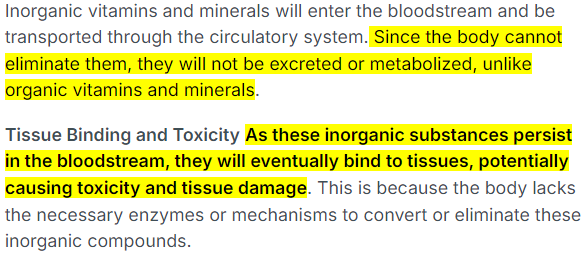
And as a note, the absorption rate within the small intestine of vitamin K supplements is about 80%, much higher than from plants. However, the same problem of conversion remains as both vitamin K1 and vitamin K2 supplements are produced from inorganic inactive forms of vitamin K. And whatever the body cannot convert will present itself as toxic and cause damage. Also, you can never be sure that the inorganic vitamin K1 in supplements are intact as the manufacturing process is extremely harsh, using solvents, enzymatic hydrolysis, fermentation, crystallization, chromatography, centrifugation, freeze-drying or spray-drying. Likely, most of it will not be recognized and converted, rendering it almost as useless as plants as a source, but even more toxic as more inorganic and unusable vitamin K will hit the bloodstream.

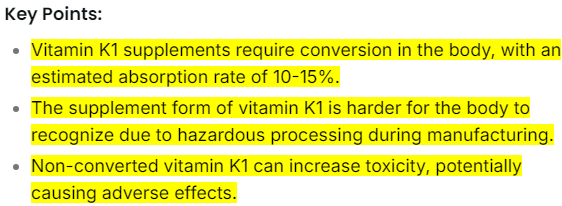

So, the only solution is to get plenty of animal-based foods — the only source of fully organic and bioavailable vitamin K, and also the only source that has zero toxins!
“To get the most out of this vitamin in kale and other plant foods, consider eating them with butter or oil. That’s because vitamin K is fat-soluble and may be better absorbed when combined with fat.”
Irrelevant, as you should never consume anything plant-based due to the extreme toxicity.
And guess what, all animal-based foods come with some of the only fat we as humans need, as in saturated fat — and always in perfect ratios in perfect synergy with its vitamin content.
This is easy to understand, as everything needed to sustain tissue health and promote life is stored in these tissues, and thus in perfect balance.


“Evidence suggests that the metabolism and functions of vitamin K1 and K2 are slightly different, though this isn’t fully understood. While dietary guidelines don’t currently distinguish between the two, it’s probably a good idea to include both types in your diet.”
The only thing we need to do is to look at tissues and they contain a lot more vitamin K2 than K1, which tells us what’s more important. And again, vitamin K2 can cover for any vitamin K1 discrepancies. Also, the half-life of K1 is only 1-2 hours, while K2 is 3-7 days. That also tells us that vitamin K1 is only needed for minor processes that are not as common, while vitamin K2 is needed most of the time.

The bottom line
“Vitamin K can be found in numerous plant and animal foods. Although deficiencies are rare, it’s important to ensure that you’re getting enough of this essential vitamin through your diet.”
Yes, as in consuming a lot more animal-based foods, otherwise all these kinds of deficiencies will only become more and more common. Never ever consume plant-based crap or processed food! Also, most people do not go to a doctor with mild symptoms and have a lot of tests run, such as a prothrombin/thrombin test — not until they end up with a severe blood clot, and then it’s not diagnosed as a “vitamin K deficiency,” but as a blood clot or as cardiovascular disease. So, again, do not trust their statistics, especially not since they want you weak, unhealthy, and dependent on their backwards and damaging “care.”
“Dark leafy greens are especially rich in this vitamin, with numerous types providing well over 100% of the DV in a single serving. Certain types of liver are good sources as well.”
No, you retarded ignorant fools. I already debunked this using simple biochemistry. A serving of the most toxic “edible” in the world, as in kale, which supposedly contains the most vitamin K1 of all leafy greens, will only yield 6.25% of the DV of actual active bioavailable vitamin K at best, if you’re healthy and can convert the vitamin, which means that most other leafy greens will not even reach a tiny 5% of the DV. And again, that is vitamin K1, and we know that it is vitamin K2 that is of most importance, as it’s readily found in our tissues, while vitamin K1 is not. And considering the extreme toxicity of plants, that is a futile and idiotic attempt to get vitamin K — even if you focus on fermented toxic soy-ridden crap as natto. In other words, Healthline’s article was utter and complete rubbish and their recommendations will severely hurt people, reducing their lifespan. Oh, you vile pieces of shit!
And that was it for Healthline’s atrocious article on vitamin K. Hopefully I made up for it with some real-world facts backed by real science and common sense. As always, if you follow something close to our natural human and carnivore diet, you will never have to worry about deficiencies, nor toxicity. Everything you need is available in meat in perfect ratios and with perfect food synergy. Throw in some organ meats every month and you’ll be golden. Personally, I only eat raw fatty meat and 5 to 8 eggs daily with some extra butter or ghee, year round, and with some veal liver every other week — and that’s what I’ve done since February 2018 to heal every health problem I had, including cancer, severe asthma, severe allergies, mild eczema, damaged lungs, damaged heart, and ulcerative colitis, and reach peak health at age 50.

If you need help with any kind of health problems or transitioning from your current way of eating to our natural species-appropriate, species-specific way of eating, I’m available for both coaching and consultation.
Coaching and Consultation

And if you found the article and my insights helpful and enjoy my daily free information, please consider donating to help pay the webhosting bills and keep the site running. And if you’re interested in discussing and sharing information with likeminded people, consider joining our uncensored community at Ungovernable.se. Thank you!

